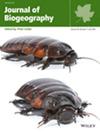Variations of Environmental Niche Breadth, Range Sizes and Geographic Exclusion With Bat Species Richness
Abstract
Aim
More species-rich communities are often assumed to contain more specialist species with narrower niches and smaller ranges. Stronger interspecific competition in species-rich communities is thought to be a key mechanism explaining these patterns. Yet, the relationship between richness and specialisation has so far only been studied for a few taxa, and characterising the effects of interspecific competition on species distributions is challenging. Here, we assess broad-scale relationships between niche breadth, range sizes and geographic exclusion along richness gradients of bats.
Location
Eastern Mediterranean, Western Asia, and Central Asia.
Taxon
Bats (Chiroptera).
Methods
Based on a novel integrated species distribution modelling approach that combines occurrence information with expert range maps, we assessed how environmental niche breadth and range sizes varied with species richness. In addition, by contrasting species' potential and realised distributions in areas where species pairs overlap, we derived indicators of geographic exclusion to understand how potential interspecific competition is affecting range limits along richness gradients.
Results and Main Conclusions
We found a nonlinear association between environmental niche breadth and richness, with the most specialised species occurring in species-poor regions and niche breadth peaking at intermediate richness. Despite a positive association of niche breadth and range sizes at the species level, range sizes in predicted bat communities declined continuously with species richness. In addition, patterns of geographic exclusion were linked to patterns of niche breadth, with species filling less of their potential range overlaps when overlapping species were more specialised. Our findings suggest that small range sizes in species-rich bat communities are better explained by the number of interacting species than by environmental specialisation or stronger exclusion between individual species. More broadly, we show how integrated distribution modelling approaches can shed new light on the interplay of species richness, specialisation and community structure, and caution against generalising relationships between richness and specialisation across taxa and geographies.


 求助内容:
求助内容: 应助结果提醒方式:
应助结果提醒方式:


